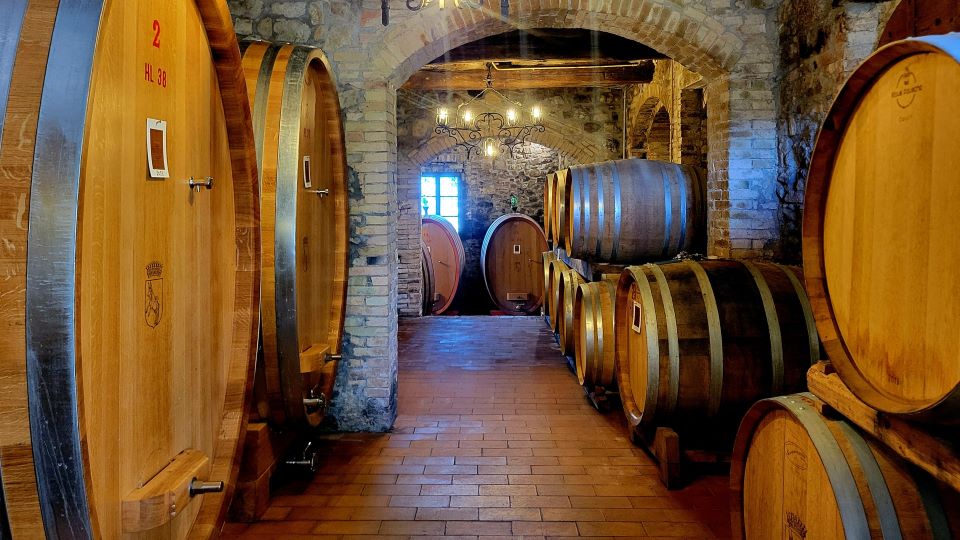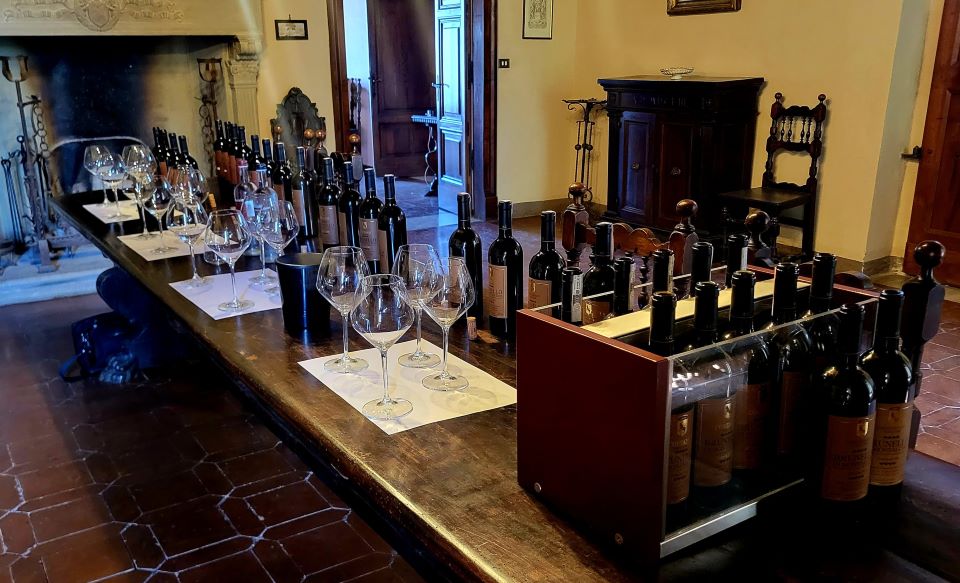Browse using the new Vinous website now. Launch →
Printed by, and for the sole use of . All rights reserved © 2015 Vinous Media
Conti Costanti: Montalcino’s Most Historic Estate
BY ERIC GUIDO | OCTOBER 01, 2024
Legacy matters, especially when it goes back over five hundred years. While some people take history for granted and squabble over the reputations of their forefathers, others rise to the occasion and become the epitome of that legacy. Beyond Clemente Santi, who was the key force in creating the Biondi-Santi brand, and his contributions to Montalcino, the Constanti family’s work during the same era was equally significant and is often overlooked.

The historic Conti Costanti vineyards as seen from the winery.
The Costanti family history in Montalcino goes back to the 15th century, when they defended Siena’s citizens against Florence’s attempt to take control of the territory. To this day, the family’s home, Colle al Matrichese, serves as Conti Costanti’s winery and offices. From a winemaking perspective, their history began in 1870 when Tito Costanti, a lawyer by trade who was considered a gentleman farmer, presented an 1865 Brunello at the Exhibition of the Province of Siena. The winemaking tradition continued through the twentieth century when Emilio Costanti (from another branch of the family) took control of Colle al Matrichese and resumed bottling Brunello in the 1960s. The modern-day Conti Costanti winery was established in 1982, when childless great-uncle Emilio Costanti entrusted his nephew, Andrea Costanti, with the family’s home and vineyards.
As a young man, Andrea Costanti didn’t consider a life in wine. He seldom spent any time with his great-uncle in Montalcino. Instead, Costanti studied geology at university and focused more on playing football (soccer) and scuba diving. Nevertheless, Emilio Costanti turned to his nephew for help. This was a major opportunity, yet also a large responsibility, especially for someone who lacked any enological and viticultural training. Unfortunately, Emilio Costanti died in 1983, shortly after Andrea’s arrival. “He died so suddenly. I didn’t have much chance to work with him side-by-side but learned a lot from his winery assistant,” Andrea Costanti recounts. To bridge the technical gap, Costanti quickly hired consulting oenologist Vittorio Fiore. With Fiore’s help and experience, Costanti bottled the 1977 Riserva and 1978 Brunello and harvested and vinified the 1983 Brunello.
Hardships followed, with the complete loss of the 1984 vintage, which Costanti describes as hot and rainy. With an open mind and determination to learn, he planted new vineyards from 1986 to 1988 to boost production. He started bottling a Rosso di Montalcino to balance the books as the Brunello aged slowly in the cellars for the four years required by law. Andrea Costanti isn’t a fan of the overuse of oak. In 1997, as President of the Consorzio del Vino Brunello di Montalcino, Costanti revised the previous aging rules, allowing winemakers to keep their Brunello in wood for two years instead of four. Initially, he was met with doubt, but ultimately, this was a visionary move. Humble and soft-spoken, Andrea Costanti is respectful and proud of all that came before him. He speaks eloquently and poetically about his love of Montalcino, and you can often find him in contemplation of his vineyards.

The historic barrel aging cellar at Conti Costanti.
Today, the winery’s holdings stand at ten hectares of vines, eight of which produce Sangiovese for Brunello or declassified Rosso, from contiguous parcels located just south and slightly east of the hill of Montalcino around the estate. This makes Costanti’s Brunello a distinctive interpretation of terroir and vintage. The estate also has a 1.5-hectare vineyard near Montosoli named Cabello Alto, entirely dedicated to Rosso di Montalcino. The oldest vines are forty-five years old, while the youngest are around ten years old, all between 400 and 450 meters above sea level in galestro soils. This exceptional area is exposed to ventilating winds that sweep through the vines nearly any time of year, preventing moisture and bringing cool temperatures at night. Over time, to contrast climate change, Costanti implemented cover crops between the rows for better water retention, leaving foliage to shade berries and replanting with high-quality clones that produce smaller bunches and berries.
Since 2023, each parcel has been fermented separately in a building dug into the surrounding hill. It is then pumped to the historical temperature control cellar (since 2020) for aging. After the first year, the wine goes into 20-25% new tonneaux. At this point, Andrea Costanti decides which barrels will be bottled as Rosso or Brunello. The wines with the most pronounced tannins, acidity, and lower pH are selected for the Riserva. Rosso is bottled, while Brunello stays for another two years in Slavonian oak barrels of 30 to 37 hectoliters before blending in stainless steel. The Riserva, however, remains separate without any extra oak aging. This is a relatively new technique in Montalcino, yet Andrea Costanti has been practicing it for over a decade. He explains, “When you produce a Riserva, you risk damaging the regular Brunello. The Riserva must be outstanding and not produced each year. It doesn’t make sense to make a Riserva too often.”

The tasting room at Colle al Matrichese.
The Conti Costanti Brunello di Montalcino Vertical
This vertical consisted of seventeen wines spanning vintages 2001 to 2020. Andrea Costanti selected either the Brunello di Montalcino or Brunello di Montalcino Riserva for each year, except for 2004, where I requested to taste the Riserva, as the Brunello was not showing well. Andrea Costanti comments that he picked the 2004 grapes a week too early following a hailstorm and subsequent very cold and dry weather. In retrospect, Costanti believes he should have included the Riserva in the blend to improve the quality of the Brunello. In the lineup, some vintages are missing, such as 2002, when no wine was made. Andrea Costanti was married in 2008 and could not find any remaining bottles; he likely had opened them prematurely. As for 2011, Andrea Costanti describes this as a “good but problematic vintage. It was warm until the last week of August, which brought a big storm and heat wave. It is a vintage that I don’t like very much. I sold most of the bottles and decided not to keep any.” Finally, 2014, when no Brunello was made again.
The winery didn't bottle any Riserva in 2000, 2002, 2003, 2005, 2008, 2009, 2011, 2013, 2014, 2017 or 2018. However, they recently released both the 2019 and 2020 Riservas.
Overall, the Conti Costanti Brunellos performed well in years I didn’t expect, such as 2003, 2005, 2017 and 2018. These are all years that Andrea Costanti decided to bottle all his Brunello production as a regular Brunello di Montalcino. However, some of the more significant vintages, like 2004 and 2006, didn't meet expectations. In each case, I added details to the tasting notes, including Andrea Costanti’s comments. The 2010 Riserva was gorgeous yet lagged behind, like other 2010s that are maturing oddly. I anticipate that consistency will only improve, especially with the addition of their new fermentation room, which came online with the 2023 vintage, and temperature control in the aging cellar. Notably, the storage rooms for back vintages have been climate-controlled since 1997.
I tasted all the wines in this article in Montalcino in July 2024.
© 2024, Vinous. No portion of this article may be copied, shared or re-distributed without prior consent from Vinous. Doing so is not only a violation of our copyright, but also threatens the survival of independent wine criticism.
You Might Also Enjoy
The Magic of 2022 Rosso di Montalcino, Eric Guido, September 2024
Buckle Your Seatbelts: 2019 Brunello and 2021 Rosso di Montalcino, Eric Guido, December 2023
The Rise of Rosso di Montalcino, Eric Guido, October 2022
The Pros and Cons of Rosso di Montalcino and Beyond, Eric Guido, January 2022
